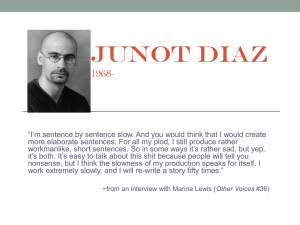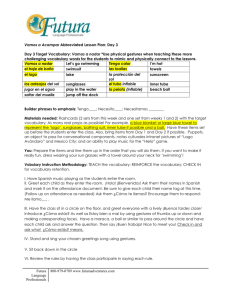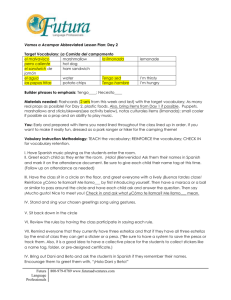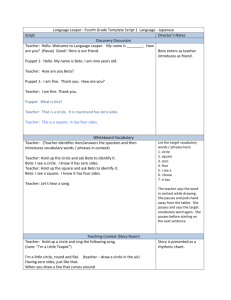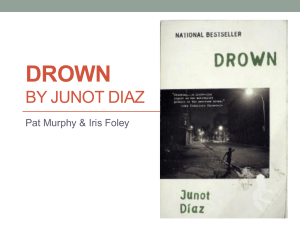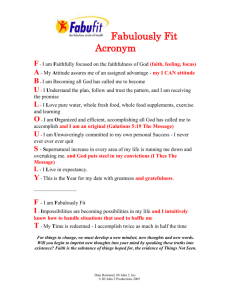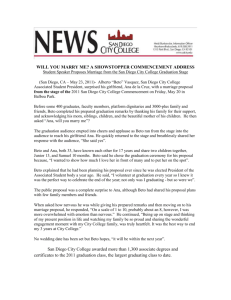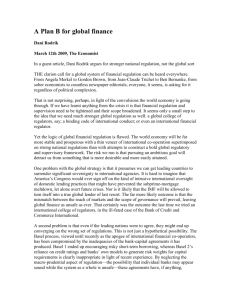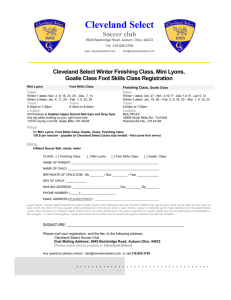Level I - Futura Language Professionals
advertisement
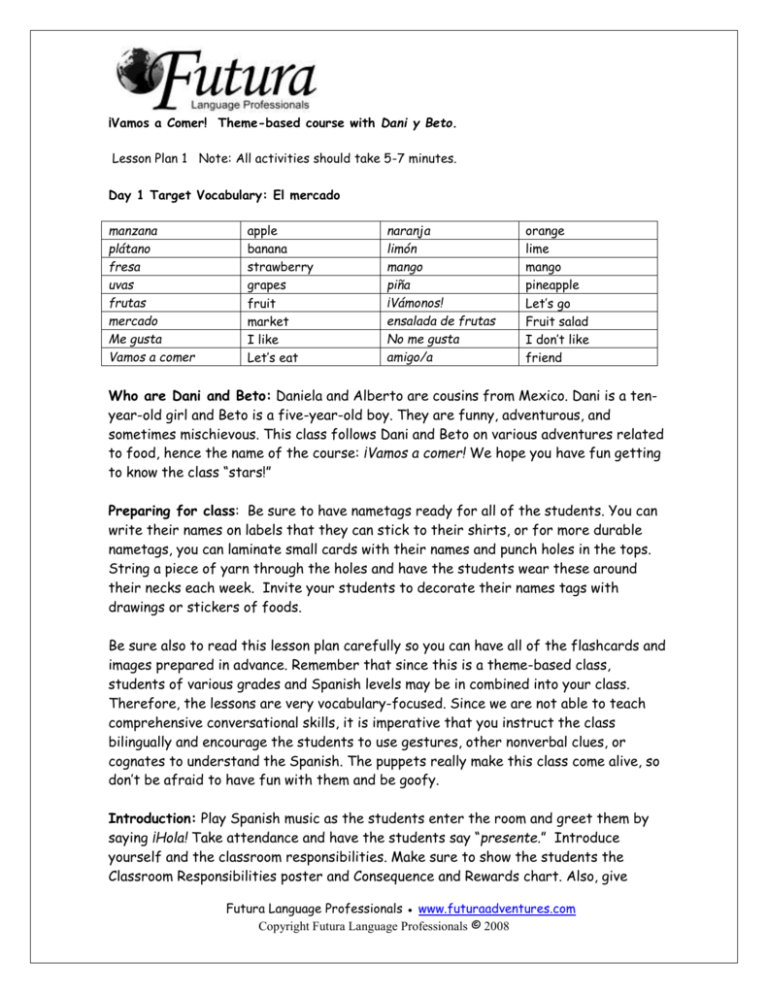
¡Vamos a Comer! Theme-based course with Dani y Beto. Lesson Plan 1 Note: All activities should take 5-7 minutes. Day 1 Target Vocabulary: El mercado manzana plátano fresa uvas frutas mercado Me gusta Vamos a comer apple banana strawberry grapes fruit market I like Let’s eat naranja limón mango piña ¡Vámonos! ensalada de frutas No me gusta amigo/a orange lime mango pineapple Let’s go Fruit salad I don’t like friend Who are Dani and Beto: Daniela and Alberto are cousins from Mexico. Dani is a tenyear-old girl and Beto is a five-year-old boy. They are funny, adventurous, and sometimes mischievous. This class follows Dani and Beto on various adventures related to food, hence the name of the course: ¡Vamos a comer! We hope you have fun getting to know the class “stars!” Preparing for class: Be sure to have nametags ready for all of the students. You can write their names on labels that they can stick to their shirts, or for more durable nametags, you can laminate small cards with their names and punch holes in the tops. String a piece of yarn through the holes and have the students wear these around their necks each week. Invite your students to decorate their names tags with drawings or stickers of foods. Be sure also to read this lesson plan carefully so you can have all of the flashcards and images prepared in advance. Remember that since this is a theme-based class, students of various grades and Spanish levels may be in combined into your class. Therefore, the lessons are very vocabulary-focused. Since we are not able to teach comprehensive conversational skills, it is imperative that you instruct the class bilingually and encourage the students to use gestures, other nonverbal clues, or cognates to understand the Spanish. The puppets really make this class come alive, so don’t be afraid to have fun with them and be goofy. Introduction: Play Spanish music as the students enter the room and greet them by saying ¡Hola! Take attendance and have the students say “presente.” Introduce yourself and the classroom responsibilities. Make sure to show the students the Classroom Responsibilities poster and Consequence and Rewards chart. Also, give Futura Language Professionals ● www.futuraadventures.com Copyright Futura Language Professionals © 2008 them an example of how they can earn a peso or lose a star, depending upon the system you choose. Demonstrate to them the attention-getter and explain how you will be using it in class to regroup the students. ¡Cantamos! Teach the students the “theme song” for the class:“Vamos a comer.” It is suggested that you sing a line first and then have the students repeat after you. Once they have a handle on the lyrics, sing the whole song together. You can make the song livelier by standing and using gestures. For example, have everyone clap during the first two lines and then pretend to be eating during the last line. Don’t forget to give instructions in both Spanish and English. Vamos a Comer (Sing to the tune of “The Farmer in the Dell”) Vamos a comer Vamos a comer Toda la clase, vamos a comer Vocabulary: After teaching the song, emphasize what the lyrics mean. “Let’s eat. Let’s eat. Everyone in the class, let’s eat.” Emphasize the phrase vamos a comer and have all the students repeat after you. Puppet time! Invite all of the students to sit down in a circle on the floor. Use your puppets to introduce the class to Dani y Beto. Put the puppets behind your back and say, “Tenemos dos amigos de la clase. We have two friends in our class. ¿Qué significa amigo? What does amigo mean?” See if anyone in the class knows the term amigo and re-emphasize it by having the entire class repeat amigo. Bring the puppets out and have them carry on the following little conversation. Be sure to use silly voices and keep this lively and fun, so the students are engaged and excited. Dani: ¡Hola! Me llamo Dani. Hi! My name is Dani. Beto: Y me llamo Beto. And my name is Beto. Dani: Tengo diez años. I am ten years old. Beto: Yo tengo cinco años. I am five years old. Dani: Somos de México. We are from Mexico. Beto: Sí, somos mexicanos. Yes, we are Mexicans. Dani: Y somos primos. And we are cousins. Futura Language Professionals ● www.futuraadventures.com Copyright Futura Language Professionals © 2008 Repaso: Check in with the students and be sure they understand. Ask the following questions and use the puppets when applicable. Don’t forget to give all volunteers a lot of praise: Muy bien, excelente, buen trabajo, etc. ¿Cómo se llama ella? What is her name? (Hold up the Dani puppet. Have the whole class repeat Dani.) ¿Cuántos años tiene Dani? How old is Dani? (Be sure to emphasize ten years old.) ¿Cómo se llama él? What is his name? (Hold up the Beto puppet. Have the whole class repeat Beto.) ¿Cuántos años tiene Beto? How old is Beto? (Be sure to emphasize he is five years old.) Son de México. They are from Mexico. ¿Quién sabe dónde está México? Who knows where Mexico is? (Have a volunteer come to the front of the room up and point to Mexico on either a map or globe.) ¿Son hermanos o primos? Are they brother and sister or cousins? (Have the whole class repeat primos/cousins.) Puppet time! Pick the puppets back up and continue the little conversation: Dani: Vamos al mercado. Let’s go to the market. Beto: ¿Por qué? Why? Dani: Necesito comprar fruta. I need to buy fruit. Beto: Bueno. ¡Vámonos! Okay, let’s go! Puppet Time: Introducing New Vocabulary “Bring” your class to the market by saying, “Bueno, clase, vamos al mercado con Dani y Beto. Let’s go to the market with Dani y Beto. ¡Vámonos! Let’s go! Gather all the students and go sit around your makeshift mercado. Have all of the fruits out on a table. Try to bring in as many real fruits as possible. Supplement the real fruits with plastic ones or images that you have glued onto cardboard or laminated so they are easy to hold up and show the class. Welcome the class to the market. Dani: ¡Bienvenidos al mercado! Welcome to the market! Teacher: ¿Qué significa mercado? What does mercado mean? Emphasize the word by having all of the students repeat it. Beto: ¿Cuáles frutas hay hoy? Which fruits are there today? Dani: ¡Vamos a ver! Let’s see! (Try and hold the Dani puppet in one hand and hold up each fruit in the other hand for the following segment.) Futura Language Professionals ● www.futuraadventures.com Copyright Futura Language Professionals © 2008 Dani: Hay fresas. There are strawberries. Teacher: Clase, repite por favor fresas. ¿Qué son fresas? What are fresas? Sí, fresas son strawberries. Dani: Tengo una manzana. I have an apple. (Hold up the apple and have the entire class repeat manzana. Verify learning by asking the follow-up question, “What is a manzana?”) Dani: Hay uvas. There are grapes. Teacher: Clase, repite por favor: uvas. ¿Qué son uvas? What are uvas? Sí, uvas son grapes. Dani: También hay naranjas. There are also oranges. Teacher: Clase, repite por favor naranja. ¿Qué es naranja? What is a naranja? Sí, naranja es orange. Dani: Quiero una piña. I want a pineapple. Teacher: Clase, repite por favor piña. ¿Qué es piña? What is piña? Sí, piña es pineapple. Beto: Dani yo quiero frutas también. Dani, I want fruits too. Dani: Un momento—¡veo una mosca! One minute—I see a fly! (Teacher: have a picture of a fly to show the class and have Beto act afraid of it.) Teacher: Clase, no queremos una mosca con la fruta. We don’t want a fly with our fruit. Entonces, necesitamos matar la mosca. So, we need to kill the fly! Juego: Mata la Mosca Hold up each fruit so far and have every student repeat with you as you say the words (fruta, fresas, manzana, uvas, naranjas, piña). Then divide your class into two teams: Team Dani and Team Beto. Hang up pictures of the fruit from the clip art on the board. (It may be nice to have this laminated to use each week.) Have one person from each team come up to the front of the room. Give each player a flyswatter. When you say a word in Spanish ,the student needs to mata la mosca or “kill the fly” on that piece of fruit. Whichever team hits the correct image first scores a point. After each word, have the class repeat it to reinforce learning. Keep playing until each student has had a turn. Cantamos: As a transition, start singing the theme song and have the students join in. Vamos a Comer (Sing to the tune of “The Farmer in the Dell”) Vamos a comer Vamos a comer Toda la clase, vamos a comer Puppet time: Introducing New Vocabulary, continued Hold up the puppets again and continue the conversation. Futura Language Professionals ● www.futuraadventures.com Copyright Futura Language Professionals © 2008 Beto: Dani, quiero frutas también. Dani, I want fruits, too. Dani: Bueno, no veo moscas ahora. I don’t see flies now. ¿Qué quieres? What do you want? Beto: Quiero un plátano. I want a banana. (Hold up the banana and have the whole class repeat the word plátano) Beto: Y quiero un mango. And I want a mango. Teacher: Clase, repite por favor mango. (Be sure to hold up the mango and use the Spanish accent for the word. You can also point out that they are the same words in English and Spanish, but they are pronounced differently.) Beto: No olivides el limón. Don’t forget the lime. (Hold up the lime and have the class repeat the word in Spanish. Later in class, the students may find it interesting how in Mexican Spanish the word limón is really lemon and lima is lime, but it doesn’t matter which you say…you will always get a lime!) Dani: Bueno, tenemos las frutas. Okay, we have the fruits. Beto: ¡Vámonos! Let’s go! Juego: Grocery Bag Game Explain to your class that you all have to help Dani and Beto pack up their fruit from the market, and it is going to be a race to see if Dani or Beto is quicker. Divide the class into two teams: Equipo Dani and Equipo Beto. Give each team a paper grocery bag. (It may be fun to put a picture of Dani and Beto on the bags to represent the teams.) Have the teams stand in a line. Make sure to have two sets of fruit on sturdy flashcards. These can be the same ones from the board from the Mata la Mosca game. It is recommended that you have these laminated for use in various activities and classes. If you are able, use real or plastic fruits to make the activity really come alive. When you call out a fruit in Spanish, the players at the front of line must race to find the correct image of fruit and put it in the grocery bag. Whoever gets the correct fruit in the bag first scores a point for his or her team. The players then go to the back of the line. Keep playing until each student has had a turn or you have named all of the fruits. Be sure to congratulate either Team Dani or Team Beto and play up the connection to the puppets. (For example, have either Dani or Beto the puppet say “Gracias” to the class while taking a bow.) After the game is complete, reinforce learning again by pulling each fruit out of the bag and asking the class to say the name of the fruit in Spanish. Be sure to continue praising the students. Puppet Time: Gather your students on the floor again, grab your puppets, and continue the conversation. Dani: Hoy fuimos al mercado. Today, we went to the market. Futura Language Professionals ● www.futuraadventures.com Copyright Futura Language Professionals © 2008 Beto: Sí, y compramos unas frutas. Yes, and we bought some fruits. Teacher: ¿A dónde se fueron Dani y Beto? Where did Dani and Beto go? (Have the entire class say the answer together: el mercado.) Teacher: ¿Qué compraron? What did they buy? (Have the entire class say the answer together: frutas.) Cantamos: Vamos al mercado Have all of the students stand up and teach them the following song with gestures. Use the song “Vamos al Mercado” on the ¡A comer! CD. However, modify the song to make it simpler and slow it down considerably. Sing each line and have the students repeat after you. Once the students have the lyrics down, you can sing the song together. You can reinforce the vocabulary words by holding up the fruits as you say them. Vamos al mercado temprano en la manaña A comprar naranjas para desayunar Vengas a la mesa Lista la comida Yum yum yum yum Rico está Vamos al mercado temprano en la manaña A comprar limones para desayunar Vengas a la mesa Lista la comida Yum yum yum yum Rico está Vamos al mercado temprano en la manaña A comprar fresas para desayunar Vengas a la mesa Lista la comida Yum yum yum yum Rico está Note: The italicized words can be changed to any of the fruit vocabulary for this class or future classes. Merienda & Notas Culturales: Futura Language Professionals ● www.futuraadventures.com Copyright Futura Language Professionals © 2008 Gather all the students on the floor and initiate a discussion about el mercado. Ask the students what they think a mercado is. Then explain how a mercado is an open-air “store” where vendors (individual people) sell all kinds of things to make money. In addition to fruits, there are vegetables, meat, clothes, housewares and sometimes even live animals! Show the students a picture of a market you found on the internet. Pass the picture around. Ask the students what they think is different about el mercado and our grocery stores in the United States. Ask if they can think of something similar in the United States. (The farmers’ market is a good example to give.) Go on to explain that at the market the vendors don’t usually have a set price for items like in the grocery store. The vendor typically says one price and then the person who wants to buy the item says a lower price. They keep going back and forth until they agree on a price. This is called bartering. (You can use the Dani and Beto puppets to briefly demonstrate bartering.) Ask students if they think supermarkets also exist in Mexico. Explain that the grocery stores with which students are familiar do exist in large cities, but that rural areas and small towns will depend much more on mercados and some convenience stores. Notes about snack time: Morning classes will not need a snack. In the afternoon classes, please make sure to bring an extra healthy snack, such as raisins or pretzels, in case the students forget their snacks. Be aware of any allergies listed on the class roll, and make sure to check with the school before class to see if food is allowed in the room you are using. (Some schools ask that snack time be held in the hallways, for example.) After snack time is over, let the students know this will be the bathroom break time where they can get a drink of water and throw away their garbage. This should be the only break for leaving the classroom in order to avoid disruptions, so remind them to take advantage of the time. If some students are not finished with their snacks, ask them to put them in their backpacks for later. Make sure to supervise the students in the hallways. ¡Cantamos!: Vamos a Comer To transition, start singing the theme song and have the students join in. Vamos a Comer (Sing to the tune of “The Farmer in the Dell”) Vamos a comer Vamos a comer Toda la clase, vamos a comer Puppet time! Teachers pick up your puppets and carry on the conversation below. Dani: Me gusta el mango. (You can make noises like yummm and pretend the puppet is eating.) Futura Language Professionals ● www.futuraadventures.com Copyright Futura Language Professionals © 2008 Beto: No me gusta el mango. (You can make “yucky” noises and have the puppet shake his head.) Teachers: Ask your class what they think Me gusta and No me gusta mean. Praise any efforts to answer. Then, formally teach the phrases Me gusta and No me gusta. (To avoid confusion, teach only the singular version of the phrase.) Activity: ¿Qué te gusta? Bring over all of the fruits. As you hold up each fruit, say the name of the fruit in Spanish and tell the students to either give a thumbs up or a thumbs down to indicate if they like the fruit or not. You can have them shout out Me gusta or No me gusta to go along with the gestures. Hand out the Me gusta/No me gusta sheet and have the students take out their crayons and pencils. Tell the students they should draw all the fruits they like under the column Me gusta and all the fruits they don’t like under No me gusta. (It is helpful to have pictures of the fruits with labels underneath on the board or on a poster for this activity.) Encourage the students to write the name of the fruit in Spanish underneath each fruit picture. Ask for one or two volunteers to come to the front and present their pictures. Be sure to encourage “aplauso” after each demonstration. Have the students write their names on the paper and hand them back to you. (Keep them in a safe place, as you will be using them in a comprehensive book the parents will get the last day of class.) Puppet time! Teachers, pick up your puppets and carry on the conversation below. Beto: Me gustan los juegos. I like games. Dani: A mí también. Me too. Beto: ¡Entonces, vámonos! Okay then, let’s go! Repaso: Manzana Caliente/Hot Potato Variation Teachers have the students gather in a circle on the floor and explain you are going to play a game of Manzana Caliente/Hot Apple. This game is just like Hot Potato, but renamed to encourage use of the fruit vocabulary. Put on music (such as the ¡A comer! CD or another fun CD in Spanish). Hand a student an apple and have the students start passing it around the circle. When the music stops, whoever is holding the apple has to answer a vocabulary question. For example: What does fresa mean? What is the word for market in Spanish? What is the English word for frutas? Any student who gets the word wrong will move to sit in the middle of the circle. Keep playing until just two students remain or you have surpassed the 5-7 minutes allotted for the activity. Futura Language Professionals ● www.futuraadventures.com Copyright Futura Language Professionals © 2008 Story time: Read a story you found from the library if possible. You can also have Dani or Beto read the stories! Two recommendations are Día de mercado by Lois Ehlert or Las frutas by Robin Nelson. Puppet time and Juego: ¿Qué falta? Dani: Quiero prepar una ensalada de frutas. I want to make a fruit salad. Beto: Sí, pero siempre olvidas algo. Yes, but you always forget something. Teachers, explain to the students how Dani and Beto are trying to make una ensalada de frutas but they keep forgetting one of the fruits. Divide your class into two teams: Equipo Dani y Equipo Beto. Put a big bowl on a desk where everyone can see it. Put all of the fruits in the bowl. Hold up each fruit and say the name in Spanish while having the students repeat after you. Explain that Dani and Beto need all of these fruits to make their salad. Tell the students to look very carefully at all the fruits and memorize them. Send one person from each team out of the room. Then, take one of the fruits out of the bowl and hide it. Have the two students come back in to the room. When the students enter the room, have one of the puppets explain,”¡Ay, no! ¡Nos falta una fruta! Oh no! We’re missing a fruit!” The first player to shout the name of the correct fruit in Spanish scores a point for his or her team. If neither player can remember the fruit which is missing or cannot remember the correct word in Spanish, they can ask their teammates for help. The teammates can only give the word in English, but the players must still answer the question correctly in Spanish. Put that fruit back in the bowl and start the game again with new players. The team with the most points wins the game. Puppet time: Closing Dani: Necesito ir a mi casa. I need to go home. Beto: Yo también. Me too. Dani: Adiós, Beto. Bye, Beto. Beto: Hasta manaña, Dani. See you tomorrow, Dani. Teacher: Clase, es la hora de ir a nuestras casas también. (Substitute escuela if this is a morning class.) It is time to go to our houses, too. Adiós: Teach the “Les Digo Adiós” song to the tune of “Jingle Bells” at the end of class. They can sing together or in rounds daily as they are cleaning and packing up. Les Digo Adiós Adiós--ya me voy Hasta luego Futura Language Professionals ● www.futuraadventures.com Copyright Futura Language Professionals © 2008 Vamos a la casa ya Les digo adiós Hand out the newsletters and parent introduction letters and have the students say goodbye to you in Spanish and hand you their nametags before leaving. Make sure each student gets picked up by his or her parent or guardian and safely leaves your classroom. Extra time: If there is extra time, you can play a fun game of Pictionary with the fruit words or Around the World with the fruit flashcard images. Both games can be adapted for future lessons. *How to play Pictionary: Split the students into two teams and make sure each team has a spot on the chalkboard or a large piece of paper on which to draw. Call up the first person in each team and tell them, in Spanish, which vocabulary word they are drawing. Make sure they know what the word is, then have them draw it for their team. The first team to correctly identify it in Spanish gets a point. For very young children, you can be the artist while the two teams guess what you are drawing. *How to play Around the World: Gather your flashcards and have the students sit in their seats. The first student gets up and stands by the first desk. Hold up a flashcard. The first student to say the word correctly in Spanish moves to the next desk to challenge that student. The losing student sits down in the desk where s/he was challenged and lost. The game keeps going until someone gets “around the world”—all the way back where s/he started. Futura Language Professionals ● www.futuraadventures.com Copyright Futura Language Professionals © 2008
